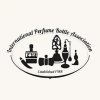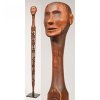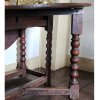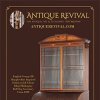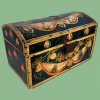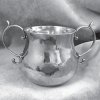The Best of the Best
October 17th, 2015
Crocker Farm, Sparks, Maryland
Photos courtesy Crocker Farm
It may be cliché; however, when the market deems something the best of the best, records are often made. This was the case on October 17, 2015, when Crocker Farm sold a seven-gallon Baltimore stoneware cooler with an incised Federal eagle decoration for a new world auction record of $483,000 (includes buyer’s premium). The buyer bidding by phone was private collector Jerry Lauren of New York City. The underbidder in the salesroom was dealer Kelly Kinzle of New Oxford, Pennsylvania. Applause rang out when auctioneer Tony Zipp sold the piece for a hammer price of $420,000. It was the highest bid ever recorded for American stoneware.

This important seven-gallon stoneware cooler from Baltimore, attributed to either Henry Remmey Sr. or Jr., with a large incised Federal eagle decoration and unusual open handles sold for $483,000 to collector Jerry Lauren bidding by phone. The underbidder was dealer Kelly Kinzle bidding in the salesroom. The price is a new world auction record for American stoneware and the highest bid ever recorded for American stoneware ($420,000). The incised eagle design on the 19¼" tall cooler possesses a stunning presence and is an adaptation of the Great Seal of the United States. Read the story for more information.
“The eagle is amazing. It supersedes anything,” said Lauren following the sale. “I never buy anything for investment. I want my art to be an integral part of my life. I knew this was coming up. I try for the best, and it is a masterpiece. I search for tens, and this is a twelve,” continued Lauren. Lauren is the creative director and executive vice president of men’s design at Ralph Lauren. It is a position he has held for 42 years.
“It took the air out the room,” said a spectator at the sale when describing the cooler. Crocker Farm was celebrating it as “a true masterpiece of exceptional decorative and historic merit.” If that seems hyperbole, the Zipp family was not alone in recognizing the importance of the piece that was attributed to either Henry Remmey Sr. or Jr.
 The cooler has large open handles with added segments in the center of each handle for added stability. The incised eagle design was an adaptation of the Great Seal of the United States, and according to the Zipps, copied by the decorator from the reverse of coins in circulation at the time. Charles Sims’s “heraldic eagle” appeared on the back of most coins and depicts a spread-wing eagle facing left, toward the arrows, its head encircled by stars and clouds, its talons clutching olive branches and arrows, and a shield across its chest. The date of origin was determined to be between the years 1812 and 1829. Henry Remmey and his son Henry Harrison Remmey came to Baltimore in 1812. They had been trained in Manhattan, New York.
The cooler has large open handles with added segments in the center of each handle for added stability. The incised eagle design was an adaptation of the Great Seal of the United States, and according to the Zipps, copied by the decorator from the reverse of coins in circulation at the time. Charles Sims’s “heraldic eagle” appeared on the back of most coins and depicts a spread-wing eagle facing left, toward the arrows, its head encircled by stars and clouds, its talons clutching olive branches and arrows, and a shield across its chest. The date of origin was determined to be between the years 1812 and 1829. Henry Remmey and his son Henry Harrison Remmey came to Baltimore in 1812. They had been trained in Manhattan, New York.
The 19¼" tall cooler has a crack extending from the rim to the midsection and minor chips along the rim and one on the stepped bunghole. The cooler was purchased by the consignor’s father in the early ’70s at a public sale in Pennsylvania. It was easily the top lot in the large 566-lot sale.
The total gross for the specialty auction was $1,160,091.25 (including buyers’ premiums). There were 92 in-house registered bidders, 282 online bidders, 83 phone bidders, and 187 absentee bidders.
This diverse sale was the fourth largest the company has ever held. The largest was 636 lots. Some rare material was offered. Two particular strengths included Manhattan stoneware and southern face jugs. Most of the Manhattan stoneware came from one collection in central New York state.

This rare stoneware pouring vessel from Manhattan, made in the late 18th century, sold to an out-of-state dealer in the salesroom for $3335 (est. $3000/5000). One side is decorated with a coggle wheel in an arched, semicircular pattern; the other side incorporates a second motif in the form of a triple-lobed drape that descends from a row of coggled semicircular drapes.

This small squat-form stoneware jar with open handles and incised decoration sold for $1092.50. The circa 1800 Manhattan jar is a rare size and form.
A Manhattan stoneware jar with vertical loop handles and vivid deep cobalt incised floral decoration sold for $9200. The decoration and incised treatment can be found on pieces dating from the last quarter of the 18th century that were produced at complexes in the city, Pot Baker’s Hill and Corlears Hook. An early, small 6¼" high rare squat-form open-handled jar with incised decoration from Manhattan, possibly used as a butter pot, sold for $1092.50; and a rare one-gallon presentation preserve jar, inscribed “Peach” and “RMC,” probably from the Crolius family and of Manhattan origin, sold for $3105. An 8" high one-pint ovoid stoneware jug with coggle decoration and stamped “Made By J. Letts / South Amboy,” cataloged as the smallest signed example of South Amboy, New Jersey, stoneware the Zipps have ever seen, sold for $2070; and a rare miniature stoneware jar inscribed “Joseph Morgan,” possibly related to someone in the Morgan family of potters of New Jersey or Manhattan, sold to a collector in the room for $2300.
The captions showcase a cross section of material from the sale. The company’s next stoneware and redware auction is scheduled for March 19.
For further information, call Crocker Farm, Inc. at (410) 472-2016 or see the website (www.crockerfarm.com).

This oval redware loaf dish with three-color marbled slip decoration and of Connecticut origin is in excellent condition and sold for $9200 (est. $5000/10,000).

This rare southern alkaline-glazed stoneware face jug, possibly from Lewis Miles’s Stoney Bluff Manufactory in the Edgefield District of South Carolina, circa 1865, sold for $33,350 (est. $20,000/30,000). Based on archaeological evidence, features of work from this operation include protruding chins and oval eyes. Also the interior of eyes and teeth lack incised details. At 8" tall, it is larger than most early southern face jugs. The buyer was a South Carolina collector in the room.

This period redware sgraffito-decorated plate attributed to Montgomery County, Pennsylvania, sold for $6325 (est. $8000/12,000). It has some spots of restoration along the edge.

This one-gallon stoneware jug with a rare cobalt cat decoration from the Cowden & Wilcox pottery and in excellent condition sold for $12,650.

This rare redware bank, likely of Pennsylvania origin, circa 1870, in the form of an African American baby in a cradle sold for $2875. The baby is holding a bottle, and the end of the cradle’s headboard is inscribed “Rastus.” The baby’s mouth is the coin slot for the bank. One foot on the baby was restored. The provenance includes Bill Koch and James and Nancy Glazer. A very similar example sold at Crocker Farm on May 21, 2005, for $4620.

This salt-glazed stoneware face jug with Albany slip decoration, sculpted in the form of a human head, is likely from Barrow County, Georgia, and sold for $9775 (est. $6000/10,000). It is missing its handle.

This figural stoneware bank, wheel-thrown and in the form of a man wearing a coat, with an applied face and holding an urn, is attributed to the J.L. Matthews Pottery in Rock Mills, Alabama, and sold for $23,000 (est. $20,000/30,000). The circa 1900 bank has a horizontal slot on the reverse. Figural banks from the South are extremely rare. The surface was treated with a salt glaze over a dipped Albany slip. It was discovered wrapped in a quilt in an attic in Alabama. The buyer was a southern pottery collector on the phone.
Originally published in the January 2016 issue of Maine Antique Digest. © 2015 Maine Antique Digest






